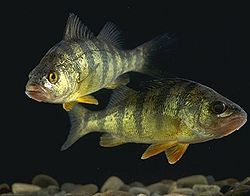Perch
| Perch | |
|---|---|
 |
|
| Yellow perch (Perca flavescens) | |
| Scientific classification | |
| Kingdom: | Animalia |
| Phylum: | Chordata |
| Superclass: | Osteichthyes |
| Class: | Actinopterygii |
| Order: | Perciformes |
| Family: | Percidae |
| Genus: | Perca Linnaeus, 1758 |
| Species | |
|
|
Perca is the genus and species of fish referred to as Yellow perch or, sometimes, perch, a group of freshwater fish belonging to the family Percidae. Perch, of which there are three species in different geographical areas, lend their name to a large order of vertebrates: the Perciformes, from the Greek perke meaning perch, and the Latin forma meaning shape.
Perch have "rough" or ctenoid scales. On the anterior side of the head are the maxilla and lower mandible for the mouth, a pair of nostrils, and two lidless eyes. On the posterior sides are the opercula, which protect the gills. Also there is the lateral line system which is sensitive to vibrations in the water. They have a pair of pectoral and pelvic fins. There are two dorsal fins, the first one spiny and the second soft. There is also an anal fin, which is also considered spiny, and a caudal fin. The cloaca lies directly behind the anal fin. All perciform fish share this general morphology.
The type species for this genus is the European perch.
Contents |
Perch as a food fish
Perch are a popular species of panfish and are considered very good to eat; the commercial catch for them has always been in high demand. This has also led to considerable misuse of the term "perch" in the restaurant business in the United States, such as "ocean perch" (Rosefish) and "rock perch" (a small bass). Many restaurants will strive to correctly advertise the offering as "yellow lake perch", or the slightly more ambiguous "lake perch". "White perch", though similarly popular, is a completely different species common in New England, and not a member of the family Percidae.
Angling
They can be caught with a variety of methods, but the two best methods are perhaps float fishing and lure fishing. The best way is to use a small hook and cast into the weeds just before the drop off. When fishing with a float, the angler will want to have a disgorger; Perch are notorious for swallowing the hook, and will need aid of a disgorger or forceps for unhooking. In many parts of the world they are also a favorite species among ice fishermen. They will take a variety of baits, including minnows, worms, maggots, bread and softshell crayfish.
Perch grow to around 5 lb (2.3 kg) or more, but the most common fish to be caught are around 1 lb (0.45 kg) or less, and anything over 2 lb (0.91 kg) is considered a prize catch. The British record perch is 6lb, beating the previous one by 1 oz.
Species
Most authorities recognize three species of perch:
- The European perch (Perca fluviatilis) is found in Europe and Asia. It is usually dark green with red fins. The European perch has been successfully introduced in New Zealand and Australia where it is known as the redfin perch or English perch. In Australia they have bred into larger specimens.
- The Balkhash perch (Perca schrenkii) is found in Kazakhstan, (in Lake Balkhash and Lake Alakol), Uzbekistan, and China. It is very similar to the European perch, and grows to a comparable size.
- The Yellow perch (Perca flavescens), smaller and paler than the European perch, is found in the United States and Canada.
- The Golden Perch (Macquaria ambigua), native to Australia. Usually found west of the Great Dividing Range through the Murray Darling river system. Grows up to 2 kg (4.4 lb) and 40 cm (16 in).
- The Silver Perch (Bidyanus bidyanus), native to Australia. Usually found in the Murray River though have been recorded north in the Darling River. Slightly larger than the Golden Perch.
- The Spangled Perch (Leiopotherapon unicolor), found throughout Australian waters, from pure freshwater to sea water though they spend most their life in fresh water. Considerably smaller than the Silver Perch and Golden Perch, grows up the 500 g (18 oz) and 30 cm (12 in).
For other perch not in the Perca genus, see Perch (disambiguation) .
References
- Gilberson, Lance, Zoology Lab Manual 4th edition. Primis Custom Publishing. 1999.